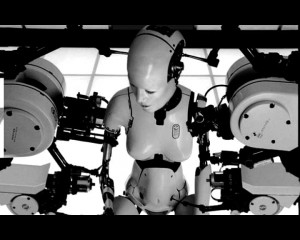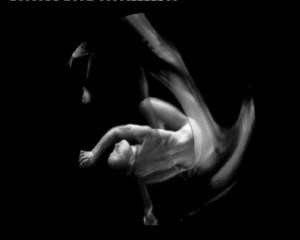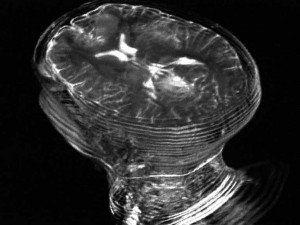Visiting the Transfigure exhibition at the Australian Centre for the Moving Image gave me a real sense that new media technologies are important for more than just the “wow” factor and are able to deliver something more than escapist entertainment.

Chris Cunningham - All is Full of Love
Works include interactive installations, online computer games, artificial intelligence, fully immersive virtual reality environments which use motion tracking and breath monitoring as navigational devices, as well as large-scale projections, computer animations, film and video.
ACMI’s Senior Producer/Curator, New Media Projects, Alessio Cavallaro, has arranged fifteen works by prominent Australian and International artists in a way which shows the historical development of screen-based art and which emphasises the thematic associations between the works. His intention was to curate an exhibition that asks, “What is our nature; our technological nature, our biological nature and our understanding of nature as nature”. The themes of body, landscape and technology are intertwined throughout the exhibition, Cavallaro explains, and culminate in Char Davies’ virtual reality works, which combine and distil the themes in an aesthetically elegant and technologically pioneering way.
The works explore the multiple meanings inherent in the exhibition’s title and the following are my interpretations.
Transfigure; configuration and reconfiguration of behaviours

Gina Czarnecki - Infected
Close to the Screen Gallery entrance is selectpark’s work acmipark, which is a multiplayer 3D world in which the avatars created by the gallery visitors play in the simulated and imaginary Federation Square that is the territory of this game. As well as being set in the gallery it can also be played online, blurring the boundaries between architectural and virtual spaces and creating a new kind of public space.
The animated single-line creatures of Ed Burton’s Sodaconstructor are constantly on the move despite being limited to a computer screen and Paul Brown’s hypnotic patterns in chromos also move to mysterious rhythms of their own.
Trans-FIGURE; extension, metamorphosis of the body in order to experience landscapes and space in new ways.
The film, video and computer animations – All Is Full of Love, Bobe’s Legend, Infected, Gift, Orka, Departure, Landscape and superpermanence challenge our ways of seeing and thinking about the body in space. The projection of a naked body dancing in Gina Czarnecki’s Infected is digitally stretched and flickers on a round screen reminiscent of a Petri dish above our heads.
Transfigure; transposition or translation from one form to another
Using Magnetic Resonance Imaging and bio-medical visualisation of DNA and molecular structures the computer animations of Justice Cooper’s Rapt and Drew Berry’s body code use data of the body to create images of our inner space, creating new vistas of previously unseen ‘bodyscapes’.
TRANS-figure; the metaphysical, transcendence of the body
Stelarc’s Prosthetic Head and Char Davies’ Osmose and Ephémère offer the visitor experiential engagement with digital representation and embodiment in a digitally created environment and suggest how these may affect our consciousness and subjectivity.

Justive Cooper - Rapt
The translucent images and spatially-activated sounds in Davies’ immersive virtual environments are an abstract aesthetic distillation of elements in nature (a forest, leaves, rocks/body organs, river/veins, human voices). Those who have experienced the work as the ‘immersant’, attest to the physical sensation of being present in the environments. The immersant also becomes part of the work as an external audience can view the immersant in silhouette on one large screen and his or her navigation through the virtual environment on a second screen.
The videos of Stelarc’s performance art incorporating bio-mechanical limbs and the artificial intelligence of his Prosthetic Head pose a series of similarly existential questions and challenge accepted notions of the location of individual consciousness.
With its wide variety of works from popular culture forms to the more philosophical and esoteric, the Transfigure exhibition has captured the essence of the world’s best contemporary screen-based art. As all good art does, the exhibition inspired me with a better understanding of myself and the world.
Maria T. Rizzo
Maria T. Rizzo is a freelance new media arts writer and production assistant based in Melbourne and is currently completing a Graduate Diploma in Arts Administration.
Transfigure was curated by Alessio Cavallaro and was held at Australian Centre for the Moving Image (AMCI), Melbourne, Victoria from 8 December 2003 – 9 May 2004.
Participating artists: Ian Andrews, Drew Berry, Paul Brown, Ed Burton, Justine Cooper, Chris Cunningham, Gina Czarnecki, Char Davies, Robert Gligorov, selectparks: acmipark, Stelarc, Mike Stubbs, Steina Vasulka, Tamáz Walizcki, Vikki Wilson
Read More
The online catalogue has excellent images, curatorial and artist statements and more detailed information about each artist and work
http://www.acmi.net.au/transfigure/flash.htm
http://www.ginaczarnecki.com/projects/2009/11/4/infected.html
Watch More
http://www.youtube.com/watch?v=6dIzBwK0xoE
 This work is licensed under a Creative Commons Attribution-NonCommercial-ShareAlike 3.0 Australia.
This work is licensed under a Creative Commons Attribution-NonCommercial-ShareAlike 3.0 Australia.






